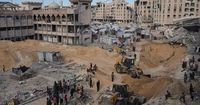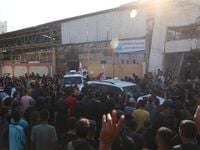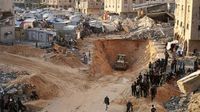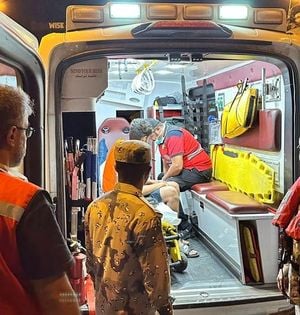On October 18, 2025, a somber exchange unfolded in the ongoing saga between Israel and Hamas, as two coffins containing the remains of deceased hostages were handed over by Hamas to Israeli authorities. The transfer, confirmed by Israel and reported by the Associated Press, marked another chapter in a ceasefire process that has been fraught with tension, tragedy, and fragile hope after nearly two years of war in Gaza.
The two bodies, whose names were initially withheld, were transported to Israel’s National Institute of Forensic Medicine for identification. Later, Israeli sources identified the remains as those of Ronen Engel and Sonthaya Oakkharasri, both abducted during the infamous October 7, 2023, attack on southern Israel—a day that saw Hamas-led militants kill around 1,200 people, mostly civilians, and take 251 hostages. The handover brought the total number of deceased hostages returned by Hamas to 12 out of 28, a key step in the week-old ceasefire process that aims to bring closure to grieving families on both sides.
Yet, even as the ceasefire held in name, its reality on the ground remained precarious. According to AP and Al Araby, the Israeli military carried out airstrikes across Gaza in retaliation for a deadly clash earlier on Sunday, when Hamas militants fired anti-tank missiles at Israeli forces near Rafah, killing two IDF soldiers: Major Yaniv Kula and Staff Sgt. Itay Yavetz. The Israeli Defense Forces (IDF) stated, “The IDF will continue to uphold the cease-fire agreement and will respond firmly to any violation of it.” Gaza medics reported at least 44 Palestinians killed in the ensuing strikes, with the Health Ministry in Gaza confirming the deaths and the return of 15 Palestinian bodies via the International Red Cross.
Amid these violent incidents, the fate of the Rafah border crossing—Gaza’s only gateway to the outside world—became a flashpoint. Israel, linking the reopening of Rafah to the pace at which Hamas returns deceased hostages, announced the crossing would remain closed “until further notice.” This decision, criticized by Hamas as a violation of the ceasefire, has left thousands of Gazans unable to seek medical treatment, travel, or reunite with family in Egypt. The closure, in place since May 2024 when Israel seized the Gaza side of Rafah, has compounded the humanitarian crisis in the enclave.
“Just like they took their captives, we want our captives. Bring me my son, bring all our kids back,” pleaded Iman Sakani, whose son vanished during the war, as she waited anxiously with other families at Nasser Hospital in Khan Younis. The scenes at the hospital were heartbreaking—one woman knelt, sobbing over a body she had just identified, while Palestinian doctors examined the remains of those returned by Israel, many still unnamed and identified only by numbers.
As part of the ceasefire agreement, Israel also returned 15 Palestinian bodies to Gaza on October 18, bringing the total number of returned bodies to 135. Gaza’s Health Ministry reported the Palestinian death toll had climbed above 68,000, with thousands still missing in the rubble. The ministry, which is part of the Hamas-run government, does not distinguish between civilians and combatants in its tally, but maintains detailed casualty records that are generally regarded as reliable by U.N. agencies and independent experts. Israel disputes these figures but has not provided alternative numbers.
The humanitarian situation in Gaza remains dire. U.N. humanitarian chief Tom Fletcher, visiting Gaza City on October 18, described “vast parts of the city” as “just a wasteland.” International food security experts declared famine in the area earlier this year, and the flow of aid has been woefully inadequate. U.N. data showed that only 339 aid trucks had been offloaded in Gaza since the ceasefire began—far short of the roughly 600 trucks per day stipulated in the agreement. COGAT, the Israeli defense body overseeing aid, reported higher numbers when including commercial and bilateral deliveries, but aid agencies and Hamas accused Israel of restricting access and blamed ongoing closures for the shortages.
Meanwhile, tensions simmered on the diplomatic front. U.S. special envoy Steve Witkoff and Jared Kushner, former adviser and son-in-law to Donald Trump, were scheduled to meet Israeli Prime Minister Benjamin Netanyahu on Monday, with U.S. Vice President JD Vance to follow on Tuesday. The United States, which has played a central role in mediating the ceasefire, issued a stark warning on October 18: “This planned attack against Palestinian civilians would constitute a direct and grave violation of the ceasefire agreement and undermine the significant progress achieved through mediation efforts,” the State Department said in a statement, referring to credible reports of an imminent planned Hamas attack against Gaza residents.
Former U.S. President Donald Trump, whose administration has been deeply involved in the mediation, raised the stakes further, warning, “If we have to, we will disarm them,” referring to Hamas in the Gaza Strip. Trump also cautioned that the resumption of hostilities by Israel remained on the table if Hamas failed to return the remains of all dead hostages.
On the ground, the pain and uncertainty continue to take a heavy toll. Families of abducted Israelis have kept up weekly rallies in Tel Aviv, demanding the return of all hostages. “We don’t want to go back to fighting, God forbid, but this whole ordeal must end, and all the hostages must be returned,” said Ifat Calderon, aunt of freed hostage Ofer Calderon. The sense of urgency and exhaustion is palpable, as the community clings to hope while grappling with loss.
Hamas, for its part, maintained that devastation and Israeli military control in parts of Gaza have slowed the handover process, and cited the presence of unexploded ordnance as a major obstacle to retrieving remains. The militant group also called on mediators to push for increased aid, as closures and Israeli restrictions continue to choke humanitarian efforts.
The cycle of violence, negotiation, and fragile truces has left Gaza scarred, both physically and emotionally. Displaced Palestinians walk through the ruins of Khan Younis, collecting water from shattered buildings, while mourners gather around bodies brought to Al Ahli Hospital after another round of deadly clashes. The war’s toll is etched into the landscape and the faces of those who have survived it, as families on both sides await news—sometimes of a return, more often of a loss.
As the ceasefire wavers and external actors press for stability, the people of Gaza and Israel remain caught in a relentless struggle for closure and dignity. The coming days will test the resilience of the ceasefire and the willingness of leaders to prioritize peace over renewed conflict, as the world watches and waits for a resolution that has, for too long, remained just out of reach.







